Treatment of chronic anal fissure. What will help with a rectal fissure? Effective folk remedies
Fissures in the anal canal are common and common problems. Patients with this diagnosis are observed by a proctologist surgeon. Pathology occurs equally in males and females, regardless of age. Cracks cause painful sensations during defecation - from weak to cutting. This problem is the main reason for the onset of anorectal bleeding in young patients.
Tears and cracks of tissue in the anus occur in adults and children.
A rectal fissure is understood as a diagnosis with proctological code K60.2 ICD-10 - a cut, rupture and cracking of tissue in the anus. The scratch can extend up to 20 mm in length, from the anus up the anal canal. A triangular or oval-shaped defect may affect the anterior and/or posterior wall.
Cracking of the tissue leads to exposure of the nerves, which, when irritated, provoke a spasm of the sphincter. Bowel movements become painful. The main causes of the problem are dense feces and/or constipation, which in the absence of adequate treatment leads to constant trauma to the intestinal mucosa. With regular spasms of the sphincter and irritation of the nerves, a persistent pain syndrome develops.
The healing of formed defects is hampered by the constant exposure to pathogenic flora that fills the rectum. The wounds in the crack become infected, which maintains the acute phase of inflammation. A protracted process leads to compaction of the edges and deepening of the ICD defect. The chronic form of the disease occurs.
If an internal fissure occurs due to chronic hemorrhoids, it is located on the side of the anal canal. The process is complicated by impaired blood circulation in the sphincter region due to hemorrhoids, which reduces the rate of tissue regeneration. Classification of cracks:
- acute - with a disease duration of up to 1 month;
- chronic - with a longer course.
If you select the correct therapeutic course with normalization of stool and pain relief, you can achieve long-term remission with wound healing. But the first diarrhea or constipation will cause a relapse of the disease.
Factors causing cracking
The main factors causing pathology:
- Dysfunction of the intestinal circulatory system. The problem is typical with a sedentary lifestyle.
- Mechanical injury to the intestine.
- Haemorrhoids. With the formation of hemorrhoids, the tone of the walls of the anal intestine decreases, so the mucous membranes are constantly damaged during bowel movements.
- Malfunctions of the central nervous system. Problems of this nature provoke prolonged sphincter spasms.
- Features of the structure. For example, in women, the muscles of the anus at the front wall are weaker, so cracking occurs in this place.
- Excessive physical activity or lack thereof. This provokes the development of hemorrhoids and other disorders accompanied by cracks.
- Late pregnancy and natural childbirth. The pressure of the growing uterus with the fetus on the rectum disrupts the blood circulation of the mucous membrane, causing the walls to weaken. Therefore, when overstretched during childbirth, a long-healing acute anal fissure occurs.
- Diarrhea provokes severe chemical irritation of the mucous membrane and bacterial contamination of the resulting erosive lesions. The problem is relevant with uncontrolled use of laxatives.
- Pathologies characterized by increased lingering, which causes bleeding of this part of the intestine with disruption of nerve endings and tissue nutrition processes. The problem often has a chronic form, which can be solved by excision of the ICD-10 fissure and laser cutting of the orbicularis anal muscle.
Signs
Overall picture:
- cutting and prolonged pain in the anal area during defecation;
- nagging pain in the sacrum and perineum, which causes urination problems and disruption of the menstrual cycle;
- constipation develops due to sphincter spasm and severe irritation of exposed nerves;
- blood in the stool and/or traces of it on toilet paper;
- itching and burning during and after bowel movements;
- anal eczema.
Symptoms acute form:
- intense pain during and after bowel movements;
- bloody discharge;
- severe spasm of the anus.
At the chronic stage, the symptoms are the same, but the manifestations are longer lasting. Pain occurs without the urge to defecate, for example, when sitting for a long time.
The appearance of a fissure in the rectum in a child
Anal scratches often occur in children under 3 years of age.
Factors provoking pathology:
- immaturity digestive system;
- constipation;
- hard feces
The symptoms of the pathology in children are the same as in adults. Additionally violated mental state child. He becomes whiny, capricious, and does not want to go to the potty. If bleeding increases, hemorrhoids or polyps may develop.
Acute anal fissures in children develop due to constipation. This type of pathology can be cured by normalizing stool.
Rectal cracking during pregnancy
The problem occurs in pregnant women due to several specific factors, depending on changes in anatomy internal organs due to the intensive growth of the uterus with the fetus. Reasons:
Treatment methods
Treatment of rectal fissures begins with the use of conservative medical methods. If there is no positive dynamics, surgery is prescribed. Measures taken to alleviate the patient’s condition:
- Normalization of stool, ensuring its regularity and soft consistency. For this purpose, a lactic acid diet is being developed. Food should contain plant fiber. Daily enemas are prescribed for the weak antiseptic solution from decoctions medicinal herbs. The procedure can be performed at home.
- Pain relief with relief of inflammatory processes. Appointed special drugs, removing pain and inflammation, for example, rectal suppositories, warm baths, microenemas. In case of severe cracking, injections are made into the crack area.
- We treat underlying gastrointestinal diseases if they exist.
The indication for surgery is severe proliferation of granular and scar healing tissue. The methods used are minimally invasive coagulation and cryodestruction. For severe defects and large cracks, classical operations are prescribed with dissection of the spasmodic area, excision of the rough edges of the crack, and suturing of the wound. Further treatment- conservative.
Traditional methods of treatment help treat cracks at home. Products made from natural ingredients in the form of pastes, decoctions, tinctures, baths, enemas, and medicinal teas are effective. For their preparation, yarrow, sage, chamomile, and oak bark are used. To make microenemas, you can take aloe and Kalanchoe. Drinks made from chamomile flowers, sage, and St. John's wort normalize the activity of the gastrointestinal tract.
Complications
Cracking of the anal opening without adequate treatment leads to infection of the overlying parts of the intestine due to the upward progression of inflammation. The sphincter, S-shaped and rectum are most often affected.
If the infection penetrates the microflora of the deep layers, inflammation of the nearby fatty tissue develops - paraproctitis. It is possible to develop severe bleeding, which provokes anemic conditions. In men, the problem can cause inflammation prostate gland With further development prostatitis.
Rectal fissure(anal fissure) is a rupture or ulceration of the mucous membrane in the final section digestive tract. The causes of the disease may be:
- chronic inflammatory processes in the intestines;
- problems with stool (constipation, diarrhea);
- rectal injury.
A clear sign of a fissure is pain in the anus during and after defecation. Painful sensations do not lose their intensity for several hours after bowel movement. From time to time in feces oh there are traces of blood. Blood stains may also remain on toilet paper and underwear. In the chronic form of the disease, there is often a fear of defecation. Complications often occur with cracks.
Treatment of rectal fissureIf you notice symptoms of a rectal fissure, you should not delay treatment. It is advisable to seek help from a proctologist. The therapy prescribed by the doctor depends on the form (acute or chronic) of the disease, the cause of the crack and the degree of injury to the rectum.
Drug treatment includes:
- therapy of the main gastrointestinal disease, which caused the pathology in the rectum;
- taking measures to normalize stool;
- local use of antiseptic solutions;
- the use of medications in the form of rectal microenemas, ointments, suppositories.
When the first symptoms of the disease appear, suppositories and ointments with an analgesic and anti-inflammatory effect are used to treat rectal fissures. Particularly popular ointments are:
- Ultraproct;
- Aurobin;
- Proctosan;
- Bepanten;
- Levomekol et al.
Suppositories are considered an effective pharmaceutical remedy for the treatment of rectal fissures. The following rectal medications should be noted:
- candles Relief, Natalsid, Posterisan;
- sea buckthorn candles;
- suppositories with benzocaine;
- suppositories with propolis;
- suppositories with glycerin.
In the chronic form, scarring of the rectal fissure is observed, and then it is necessary surgical treatment– excision. Traditional surgery It takes place under general anesthesia, and considerable time is required for the patient to recover. Nowadays it is increasingly used laser surgery, coagulation or cryodestruction. With these methods of eliminating a crack, local anesthesia is used, and rehabilitation is quite quick.
Treatment of rectal fissures with folk remedies
On initial stage diseases, it is possible to treat rectal fissures at home. Traditional medicine contains quite a few effective recipes. We present the most effective of them.
Potato candles
A piece is cut out of a raw potato, similar to a rectal suppository. A potato candle is dipped in honey and carefully inserted into the anus. The procedure before bedtime is repeated for 1-2 weeks.
Propolis with butter
A pea-sized piece is dissolved in two tablespoons of softened butter. Soak a napkin in the mixture and apply it to the anal area, leaving it overnight.
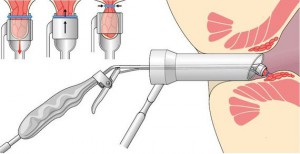
Sitz baths with a decoction of young pine twigs
Two handfuls of pine shoots are boiled in three liters of water and diluted with cold water to bring the temperature closer to room temperature. Daily 10-minute pine baths promote rapid healing of cracks.
Microclysters for the treatment of cracks
The cooled infusion of pine needles can be used in the form of microenemas introduced into the rectum. Speedy healing is ensured by microenemas with infusions of chamomile or sage, honey water, sea buckthorn and rosehip oils, and fish oil.
Among all diseases of the large intestine, rectal fissures account for about 13%. This means that 2 out of 100 people suffer from this disease. Young and middle-aged women get sick more often than men. In men, this disease more often occurs in old age.
Causes of rectal fissure:
There are many reasons for this pathology. It can be caused by mechanical trauma, vascular pathology (hemorrhoids), changes in the epithelium of the rectal mucosa (parakeratosis) and other processes. But most common reason is an injury to the epithelium of the rectum, which most often occurs during the act of defecation when dense feces pass through the rectum or during prolonged stretching.
In women, the rectum is separated from the vagina by a thin wall, which is the first to be damaged. Moreover, with chronic fissures of the rectum in women, a rectovaginal fistula (from Latin: rectum - rectum; vagina - vagina) can form at the site of the defect in the anterior wall of the rectum - a hole connecting the rectal cavity with the vaginal cavity. This, in turn, can cause disruption of the vaginal microflora and lead to gynecological and urological problems (vaginitis, endometritis, cystitis, pyelonephritis and others). A rectal fissure in women can also form as a result of a difficult birth, when a large fetus stretches and tears the tissue crotch. This is also related to the anatomy of the pelvic organs in women.
Quite often, a rectal fissure is combined with hemorrhoids, which increases the likelihood of acute anal fissure into chronic.
Due to the fact that the intestines contain about 2-3 kg of various bacteria (Escherichia coli, Proteus, staphylococci, streptococci and others), which under normal conditions do not penetrate the body and do not cause infectious diseases, if there is a rectal defect, they can cause bacterial inflammation. This inflammation can subsequently go deeper into the deeper layers of the rectum and even go beyond its limits. As a result, purulent melting of fatty tissue around the rectum occurs (paraproctitis). The temperature rises, severe, sometimes throbbing, pain and spasm of the anal sphincter appear. This makes defecation almost impossible. Treatment of this disease only surgical - opening and removal of pus with the use of antibacterial drugs.
Classification of anal fissures:
1) According to the duration of the disease :
a) acute rectal fissure (up to 4 weeks);
b) chronic fissure of the rectum (more than 4 weeks and the presence of calloused edges).
2) By location in the anal canal :
a) posterior wall (more common in men) – 88% of patients;
b) anterior wall (more common in women) – 9% of patients;
c) side walls (more often in people suffering from hemorrhoids) – 3% of patients.
3) According to the condition of the anal sphincter :
a) with spasm of the anal sphincter;
b) without spasm of the anal sphincter;
4) According to the presence of complications :
a) without complications;
b) with complications (bleeding, acute paraproctitis).
Symptoms of a rectal fissure are as follows:
a) Pain in the anus, especially during bowel movements. Moreover, if this is an acute fissure of the rectum, then the pain will be strong, constant and not long-lasting (mainly during bowel movements and for half an hour after). With a chronic fissure, pain lasts longer and can occur not only during bowel movements, but also in other situations (for example, when standing in a certain position for a long time). As a result, patients develop "chair fear" . If the pain becomes unbearably severe, then most likely the patient has developed a complication in the form of paraproctitis - purulent inflammation fatty tissue and other tissues around anus.
b) Spasm of the anal sphincter. This spasm is a reflex response to pain. On the one hand, spasm causes discomfort and other pathophysiological problems, but on the other hand, during spasm, the vessels of the rectal mucosa are compressed, which reduces bleeding.
c) Bleeding from the rectum (rectal bleeding). It can be detected after a bowel movement (as if mixed with blood) or on underwear. Rectal bleeding usually does not result in significant blood loss, but chronic blood loss at a rate of more than 10 ml of blood per day can lead to such pathological conditions How iron deficiency anemia and sideropenic syndrome (brittle nails, hair, peeling skin, etc.). This is due to the fact that the blood contains a lot of iron and its removal from the body exceeds its intake.
These signs of rectal fissure ( pain, spasm and bleeding) are a characteristic triad of signs for this pathology and allow the doctor to make a diagnosis after the first interview with the patient.
Treatment of rectal fissure:

Doctors begin treatment of rectal fissures with a conservative method. Sometimes it is enough to simply normalize stool, its frequency, and consistency with the help of special diets and medications. The diet is prescribed for a period of up to 6 weeks, and all salty, sour foods, as well as alcoholic products should be excluded from the diet.
Currently, suppositories are used as one of the conservative measures to treat rectal fissures. There are many patented rectal suppositories (ultraproct, procto-glivenol, hepatrombin and others). Suppositories should be used as follows: after defecation, you need to take a warm sitz bath and only then insert the candle. These manipulations are performed 2 times a day, the second time at night. You can also make rectal suppositories yourself using recipes traditional medicine, which will be discussed below.
You can use special antiseptic and analgesic ointments. These ointments are sold in bottles with a special tip that allows you to squeeze the ointment into the rectum.
Of no small importance are medicines containing nitroglycerin, which helps relax the rectal sphincter. To do this, use 0.4% nitroglycerin ointment, which is used 2 times a day for no more than 8 weeks. All manipulations are performed after defecation and toileting of the rectum.
The effectiveness of conservative treatment methods used in combination is about 72%.
If conservative treatment is not effective within 8 weeks, then surgical treatment is indicated.
Surgical treatment:
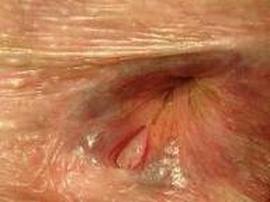
Until a chronic rectal fissure has formed, surgery is not indicated. The operation itself consists of excision of a rectal fissure along the plane of the fissure within the healthy mucosa. After excision, the wound usually heals within one week. During this time, the patient needs to maintain soft stools both immediately after surgery and during the rest of his life.
Prognosis of the disease: conservative and surgical treatment together ensure recovery in almost 100% of patients.
Alternative treatment for rectal fissures:
As popular measures Treatments include substances such as aloe juice and fish oil. The juice is squeezed from three-year-old aloe and mixed with fish oil in a 1:1 ratio. One raw chicken egg is also added here. All this is thoroughly mixed and introduced into the rectum using a syringe. For complete healing of the crack, 15 such procedures must be performed.
 To treat this disease, you can use dandelion, or rather powder from its root.
This powder is eaten daily, 1 teaspoon 3 times a day. You can use yarrow infusion to enhance the effect. Yarrow herb is crushed and brewed 2 teaspoons in a glass of water, let it brew for 30 minutes. The infusion is drunk warm.
To treat this disease, you can use dandelion, or rather powder from its root.
This powder is eaten daily, 1 teaspoon 3 times a day. You can use yarrow infusion to enhance the effect. Yarrow herb is crushed and brewed 2 teaspoons in a glass of water, let it brew for 30 minutes. The infusion is drunk warm.
The arsenal of traditional medicine also includes motherwort and plantain herbs, chamomile flowers . Of all these herbs you need to take one teaspoon and mix with melted beeswax. Suppositories of 130 grams each are made from this mixture and inserted into the anus 3 times a day.
The following folk remedy has the following composition: 1 part celandine to 3 parts yarrow, St. John's wort, chamomile (flowers) officinalis . Mix everything. Add this 2 tablespoons per glass of boiling water, let it brew for 2-3 hours. Drink half a glass 4 times a day.
It is also necessary to perform hygiene procedures. After defecation, the anus should be washed with cool or warm water. Toilet paper should not be rough, but it is better to abandon it altogether.
And most importantly, it is easier to prevent a disease than to treat it. Try to eat right, eat 5 times a day, drink about 2 liters of water a day, drive active image life, sit at the computer less, do gymnastics periodically. In a word - lead healthy image life and all illnesses will pass you by.
Video: treatment of anal fissure
One of the most commonly diagnosed proctological diseases is rectal fissure. It is a cut or rupture on the mucous membranes of the anus, ranging from a few millimeters to two centimeters in length.
The disease occurs in people of different age groups, although women suffer from it somewhat more often than men; the defect also occurs in children in some cases. Typical causes of occurrence are long-term regular problems with stool, inflammation of the gastrointestinal tract and mechanical injuries from foreign objects.
Often the defect occurs against the background of other diseases.
The disease is accompanied by extremely unpleasant symptoms, such as acute pain in the anus during bowel movements and for some time after, bleeding from the anus, and frequent constipation.
A chronic fissure is characterized by less intense pain, but longer in duration, discharge of pus from the anus and often fear of walking “in a big way.”
To prevent unpleasant consequences, treatment should be started immediately after the first symptoms are detected. If an acute crack does not heal, then a month after its appearance it becomes chronic.
Therefore, treatment should not be delayed under any circumstances.
General principles
Complex therapy of the disease is aimed at reducing pain, normalizing stool, eliminating spasms of the anal sphincter and fast healing fabrics. Treatment is usually limited to conservative methods, but in some cases surgery is performed.
Drug therapy includes a number of main aspects:
- Enemas with a weak antiseptic solution, laxatives;
- Medicines with anti-inflammatory and analgesic effects in the form of microenemas, anal suppositories and herbal baths;
- Drugs for the treatment of the underlying disease against which the crack developed;
 An important condition is compliance with dietary recommendations. It is necessary to exclude from the daily menu foods that irritate the organs of the digestive system - alcohol, marinades, smoked meats, hard foods. If the crack appears due to constipation, then it is better to refuse white bread(especially soft) and red meat.
An important condition is compliance with dietary recommendations. It is necessary to exclude from the daily menu foods that irritate the organs of the digestive system - alcohol, marinades, smoked meats, hard foods. If the crack appears due to constipation, then it is better to refuse white bread(especially soft) and red meat.
Preference should be given to raw fruits and vegetables, dried fruits, fermented milk products, wholemeal bread, vegetable oil, various cereals.
You should eat nuts and legumes several times a week. This diet promotes regular bowel movements and does not require volitional efforts on the part of the patient.
During the entire course of treatment, you must not carry heavy objects. But moderate physical activity is welcome, for example, hiking, swimming in the pool.
Conservative methods
Treatment of this defect is exclusively local. The main pharmacological agents are suppositories and ointments, which effectively eliminate pain and inflammation, heal the wound and reduce spasms of the walls of the anus. The following types of rectal suppositories have proven themselves to be positive:
- Relief - contains shark liver oil, which has a hemostatic and analgesic effect;
- Posterizan - not only extinguishes inflammatory process, but also increases the body's defenses;
- Suppositories with propolis - you can buy them at the pharmacy or make them yourself. To do this, grate the frozen propolis, mix with butter, melt everything in a water bath and leave in the molds to harden;
- Methyluracil. Effectively and quickly heals wounds;
- Witch hazel. Homeopathic suppositories based on plants;
- Natalsid. Completely safe, no side effects and suitable for use during pregnancy;
- Hepatrombin - stops bleeding and quickly heals damage to the mucosa.
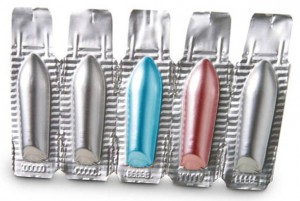 There are also special analgesic suppositories. To get rid of fissures, ultraproct, anestezol, betiol, proctoglivelone, salofalk, as well as ichthyol and glycerin suppositories are most often prescribed.
There are also special analgesic suppositories. To get rid of fissures, ultraproct, anestezol, betiol, proctoglivelone, salofalk, as well as ichthyol and glycerin suppositories are most often prescribed.
Antispasmodics include an ointment containing nitroglycerin and suppositories with papaverine. By reducing spasm of the anal muscles, it occurs pain reduction and the treatment itself progresses faster.
It is useful to carry out sitz baths (“fifth point” - in a basin) with potassium permanganate or with a decoction of healing herbs. Duration - from 15 to 20 minutes several times a day and always after relief and hygiene procedures.
Surgical treatment
 Treatment is currently carried out non-traumatic and safe methods- laser coagulation or cryodestruction (exposure to cold nitrogen). Local anesthesia is used, and the patient can leave the hospital shortly after the operation. Recovery period short, but it is recommended to follow the nutritional rules for a long time.
Treatment is currently carried out non-traumatic and safe methods- laser coagulation or cryodestruction (exposure to cold nitrogen). Local anesthesia is used, and the patient can leave the hospital shortly after the operation. Recovery period short, but it is recommended to follow the nutritional rules for a long time.
If the lesion has a large area, then surgery can be carried out traditional method. Procedure in progress under general anesthesia and consists of cutting the sphincter, excision of the edges of the crack and suturing the wound edges. After the operation, a strict diet with a large number of laxative foods is indicated.
Folk remedies
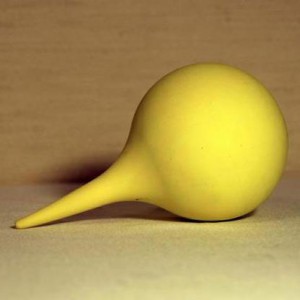 Traditional methods of treatment with a reasonable approach help even without the use of pharmaceuticals. Side effects excluded, and the therapeutic effect is delicate and gentle.
Traditional methods of treatment with a reasonable approach help even without the use of pharmaceuticals. Side effects excluded, and the therapeutic effect is delicate and gentle.
To prepare rectal suppositories
The microenema ointment is prepared as follows: mix raw egg white, 2 hop cones and a tablespoon fish oil and aloe juice. First, prepare a strong infusion from the cones (you will need 100 grams of boiling water), let it sit for 20 minutes. Mix the infusion with the rest of the ingredients. Insert into the anus in the evenings for 10-15 days.
A special gel will also help heal cracks: mix a spoonful of aloe juice with raw egg and a spoonful of fish oil. Apply to the damaged area using a sterile cotton swab.
A rectal fissure is a small, narrow tear or ulceration in the lining of the rectum (the short final section of the digestive tract). This disease is formed as a result of excessive stress on the anus (due to physical tension, persistent constipation and / or increased tension on the anal sphincters). It can also lead to rupture chronic failure blood circulation in the mucous membrane and close proximity to infections.
There are two forms of this disease - acute and chronic. If you encountered it for the first time, then you are dealing with the first form. Cracks that do not heal for more than 6 weeks are called chronic. Treatment of a rectal fissure is simple; it can be done at home on your own (especially in the acute form). To do this, it is enough to use simple folk remedies.
- Try to defecate as soon as you feel the urge (you should not delay defecation).
- Drink plenty of fluids - about 7-8 glasses a day.
- Your diet should have plenty of fiber.
- If necessary, use stool softeners (liquid paraffin suppositories) or laxatives - remember that these measures should not become a habit.
- There is no need to push hard during bowel movements.
- Avoid anal sex.
Treatment
The disease should be treated as soon as you notice the first symptoms. For this, healers recommend using proven folk remedies - these include homemade candles, sitz baths, and compresses. By combining different techniques, you will speed up your recovery.
Candles
The suppositories penetrate deep into the rectum, acting at the local level. Here are some popular recipes.
Cold candles
 Cooling, analgesic and hemostatic suppositories, ice suppositories have helped many patients get rid of this delicate disease. Mix 1 teaspoon each of chamomile, sage, tansy and birch leaves. Pour this mixture with a liter of boiling water and leave for 1 hour, then strain. You need to freeze the resulting infusion in molds that fit the size of the candles - for this you can use rubber gloves (pour the liquid into your fingers and wrap them with thread). After the candles in the refrigerator freeze, insert them one at a time into the anus at night. The course of treatment consists of ten procedures, but after the first suppository you will feel significant relief. Additionally, use other folk remedies.
Cooling, analgesic and hemostatic suppositories, ice suppositories have helped many patients get rid of this delicate disease. Mix 1 teaspoon each of chamomile, sage, tansy and birch leaves. Pour this mixture with a liter of boiling water and leave for 1 hour, then strain. You need to freeze the resulting infusion in molds that fit the size of the candles - for this you can use rubber gloves (pour the liquid into your fingers and wrap them with thread). After the candles in the refrigerator freeze, insert them one at a time into the anus at night. The course of treatment consists of ten procedures, but after the first suppository you will feel significant relief. Additionally, use other folk remedies.
Potato candles
If you are not bleeding or severe pain, then use potato candles instead of ice candles. They are extremely easy to prepare. Cut a piece out of a potato that resembles a rectal suppository in shape and size. Before going to bed, dip this candle in honey and insert it into the anus. You need to do this for 1-2 weeks, until everything unpleasant symptoms will not disappear in this zone.
Cornmeal and plantain candles
Very effective suppositories that will help cure even advanced chronic cracks. Grind in a meat grinder fresh leaves plantain, squeeze the juice out of them. To this juice you need to add corn flour and knead into a tight dough. Make candles from the dough and place them in the freezer. At night, insert candles into the anus. Soon your illness will disappear without a trace.
Sitz baths
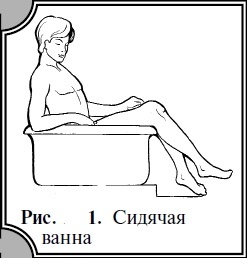 Sitz baths quickly relieve pain and irritation in the rectum, and also improve blood circulation in the mucous membrane, which is very important for the treatment of cracks. Therefore, you must do them - preferably in the evening, before introducing suppositories.
Sitz baths quickly relieve pain and irritation in the rectum, and also improve blood circulation in the mucous membrane, which is very important for the treatment of cracks. Therefore, you must do them - preferably in the evening, before introducing suppositories.
Baths made from a solution of potassium permanganate - disinfect the sore spot and slightly dry the cracks. The water temperature should be about 40C, the solution should have a faint pink color. Sit in this bath for about 20 minutes, then thoroughly but very gently dry your skin with a towel.
Baths made from young pine shoots perfectly relieve pain and bleeding. Boil two large handfuls of young shoots in 3 liters of water (they should boil for at least an hour), then cool the broth to the required temperature and make a sitz bath. Repeat the procedure every other day. Additionally, use other folk remedies.
Brewing regular tea is also suitable for baths - after all, it has tanning properties. Brew a strong brew of black tea, pour it into a bowl, dilute with a small amount of water and sit in the basin for 15-20 minutes.
Chamomile is a universal doctor that will help you with rectal fissures and many other diseases. To prepare the bath, brew 4 tablespoons of the flowers of this plant in 2 liters of boiling water, cover and leave for 20 minutes. Then strain the infusion, pour it into a bowl and dilute with water.
Compresses
Compresses are usually left on all night, so they last much longer than baths. Here are some proven recipes.
- Take 2 tablespoons of crushed ambrosia marigold, pour 2 glasses cold water and boil for a few minutes. In the cooled broth, moisten a piece of gauze folded in several layers and apply to the anal area overnight. In the morning, rinse your anus with clean water.
- Prepare an infusion of raspberry leaves: pour 2 tablespoons of dry crushed plant with a glass of boiling water, cover with a lid and wait half an hour. You need to make compresses from this infusion. Traditional healers also recommend using it internally to normalize the function of the rectum and relieve the inflammatory process.
- Dissolve a piece of propolis the size of the eye of a pin in 2 tablespoons of soft butter. Apply this mixture to a napkin and apply to the anus overnight.
Write in the comments about your experience in treating diseases, help other readers of the site!
Share the material on social networks and help your friends and family!
